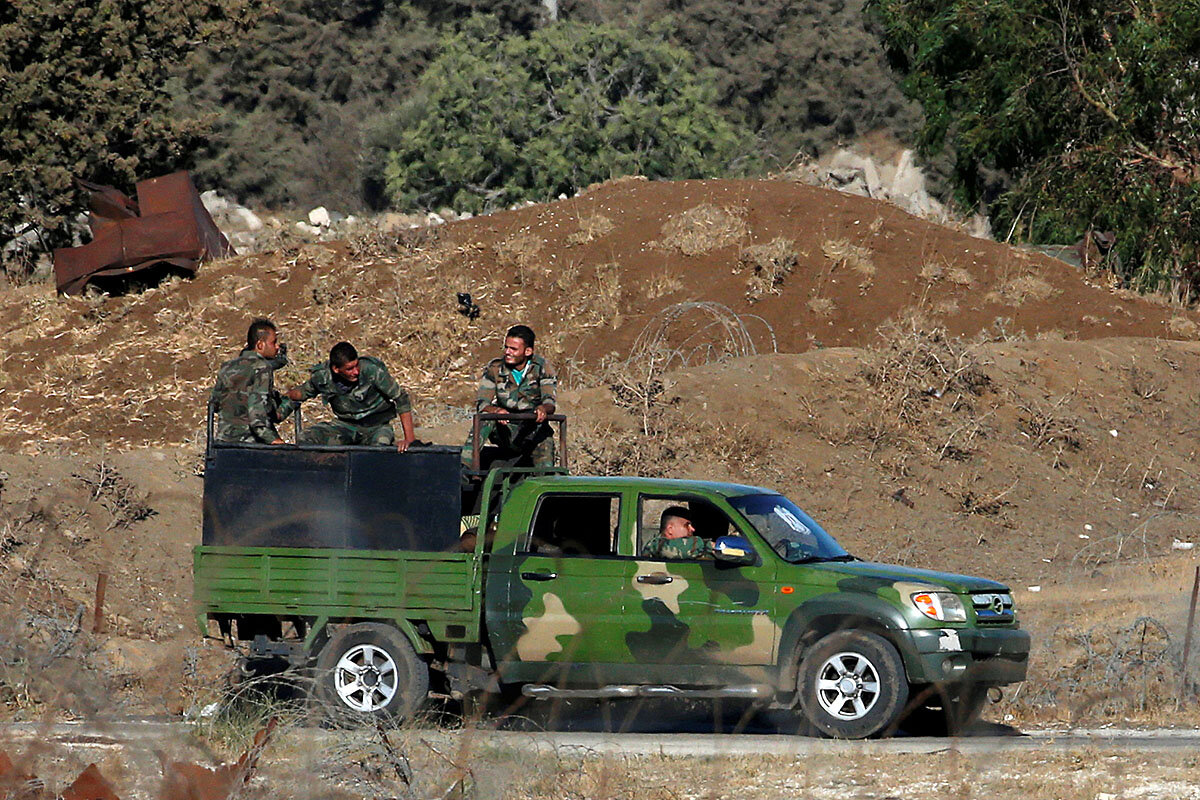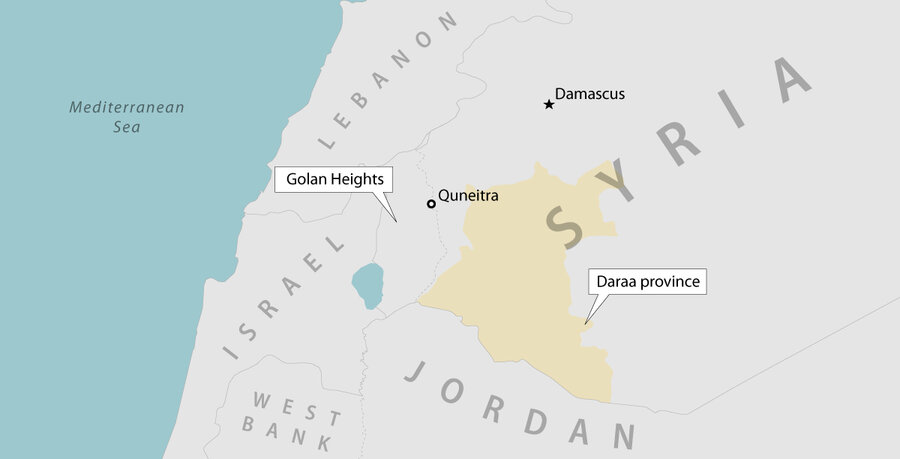What Russian deal? Israel and Jordan cast wary eye toward Syria.
Loading...
| AMMAN, Jordan
With the United States increasing pressure on Iran, concerns are rising that southern Syria could be a flashpoint for growing tensions between Iran and the U.S., Israel, and the Arab world.
It became clear in 2018 that Syria’s Russia- and Iran-backed president, Bashar al-Assad, had emerged as the victor in his country’s civil war. And Russia, the main power broker, pledged to both Israel and Jordan that security arrangements for southern Syria would keep Iranian forces 70 to 80 kilometers (43 to 50 miles) from their borders.
Israel and Jordan took that pledge to include Iran’s proxies, especially the Lebanese Shiite militant group Hezbollah.
Why We Wrote This
Israel and Jordan are disappointed with a security deal that hasn’t stopped Hezbollah from entrenching itself in southern Syria. Can the U.S. provide positive leadership there?
But one year later evidence is solidifying that Hezbollah has become increasingly entrenched in the area, and Russia now appears either unable, or unwilling, to deliver on its pledge.
With U.S. diplomacy also notably diminished on Syria, concern is growing among Israel, Jordan, and regional analysts that an unintended and potentially “devastating” escalation may be around the corner in which no one would be able to back down.
“Russia promised that the Iranians and militias would be driven out from southern Syria, and Russia did not deliver the goods,” says Ely Karmon, senior research scholar at the International Institute for Counter-Terrorism in Herzliya, Israel.
The alleged Russian response to Israel? The agreement concerned Iranian forces, not their agents.
Tit for tat
After Hezbollah sent thousands of fighters in 2013 to prop up President Assad, Israel began a campaign of surgical strikes against Hezbollah and Iranian military installations and leaders near the Israeli-held Golan Heights and weapons convoys headed toward Lebanon.
Unwilling to take sides in the civil war, Israel refrained from targeting Syrian regime forces, focusing instead on preventing Hezbollah and Iranian Revolutionary Guards from establishing a second northern front on the Golan.
Iran and its militias, consumed with bolstering Mr. Assad’s flagging forces, refrained from responding in force.
It was a low-level tit for tat: Israel would strike Iranian bases or a missile convoy; Hezbollah would fire on Israeli military patrols or bases on the Golan.
“The Israelis have been careful with what they have targeted, and the targets have concluded that now is not the time to push back,” says Jon Alterman, senior vice president of the Center for Strategic and International Studies (CSIS) in Washington.
The containment had worked. Until now.
Hezbollah cements its presence
Israel’s containment policy is now reaching its limits, with Hezbollah and Iranian proxies reportedly embedding themselves in southern Syria.
According to security sources and analysts, Hezbollah has 7,000 to 10,000 forces across Syria, with another 8,000 to 12,000 Shiite fighters loyal to Iran from Iraq, Afghanistan, and Yemen that coordinate with the Lebanese group.
But as Mr. Assad cemented his control over the country in the last year, security sources say Hezbollah’s presence in southern Syria has grown dramatically – with reportedly 1,000 fighters in the Daraa region near Jordan and in Quneitra, facing Israeli forces on the Golan.
Former Free Syrian Army rebels who have returned to their hometowns in southern Syria after an amnesty agreement with the regime say Hezbollah is effectively “governing” several towns and villages.
Hezbollah and Shiite militias patrol areas dressed as uniformed Syrian regime forces in order to avoid being hit by Israeli airstrikes, they say, or, more frequently, deploy former rebel fighters to patrol areas and provide intelligence directly to the Iran-backed paramilitary group.
“Either you answer to Hezbollah, or you leave,” says Abu Mohammed, a former rebel who had previously lived in Jordan and did not wish to use his real name.
The claims, like most developments in regime-controlled Syria, are difficult to verify.
But multiple Syrians also report their homes and entire neighborhoods have been overtaken by Shiite militias and their families – part of a planned “demographic change” in the south.
More concerning for Israel is the fact that Hezbollah has gained urban warfare experience from the civil war, tactical planning knowledge from coordinating with the Russians and Iranians, and an extensive armory of ballistic missiles, guided missiles, and armed drones.
The Israeli daily Haaretz stated that Iran was transforming villages in southern Syria into “fortresses,” indicating that since the Russia agreement, “Hezbollah was actually more active in the region, and the organization was reestablishing its terror networks in southern Syria.”
Escalation fears
With the U.S. upping its economic and military pressure on Iran, fears are growing in Amman and among the Israeli security establishment that Tehran may activate Hezbollah to strike back in response.
Previous flare-ups in Syria have been linked to pressure on Iran: On May 8, 2018, the very same day President Donald Trump announced the U.S. withdrawal from the Iran nuclear accord, Israeli strikes hit Iranian targets at a military base outside Damascus.
Two days later, Iran-backed militias launched 20 rockets at Israeli military bases on the Golan Heights, leading Israel to strike yet again at several Iranian installations across the country.
Moscow, which is looking to draw down its physical presence in Syria while securing the economic payoff of its involvement in the form of Syria’s natural gas reserves and reconstruction contracts, is trying to avoid conflict.
But Russia has proved ineffective at curtailing Iranian involvement and military activity in Syria, Arab and Israeli security experts say.
Instead, Moscow has given Israel a “green light” to slowly drive Hezbollah and Iranian militias away from the border without igniting an open conflict, refusing to deploy its missile defense systems in Syria against Israeli airstrikes.
Regional security experts have called the arrangement “careless” on Moscow’s part and “playing roulette.”
Jordan too fears another conflict on its borders, and the blow it would deliver to an economy that has only just started to recover from the fallout of the Syrian war.
But a long-term Hezbollah presence on its borders is also seen as “unacceptable,” out of belief the militia will be an obstacle to Jordan-Syria relations and trade, and may attempt to smuggle arms and drugs into the kingdom.
Adding to the uncertainty is Israeli elections.
“There are always risks of miscalculations, and you certainly have that when Israel is engaged in an election campaign,” says Mr. Alterman of CSIS. “You don’t want to get sucked into a war that is unwinnable, but you also don’t want to look impotent in the face of confrontation.”
Wanted: an off-ramp
All agree that American leadership could be one of the few factors that could help prevent Iran’s Syria presence from igniting a regional tinderbox.
U.S. and Turkish officials reportedly are close to an agreement that would prevent hostilities on Syria’s northern border, near where U.S. forces are deployed. But according to regional diplomats, American diplomacy on nearly anything else related to Syria is missing.
“This is the central issue: not the U.S., not Israel, not the Iranians, not even Hezbollah know what will happen if there was an unintended provocation in terms of consequences and in causalities,” says Mr. Karmon, the Israeli researcher.
“It is a game of brinkmanship where you can lose control.”
Meanwhile, a U.S. military withdrawal from Syria would allow Iran to control a direct land corridor running through Iraq and into Syria toward the Golan, further fueling the potential for conflict.
“We want the U.S. to maintain a presence in Syria, but also to provide diplomacy to give everyone an off-ramp,” says one Arab diplomat, who was unauthorized to speak to the press.
“If the U.S. does not create that ramp, we don’t know who can.”







